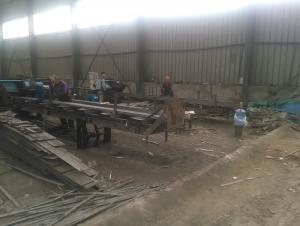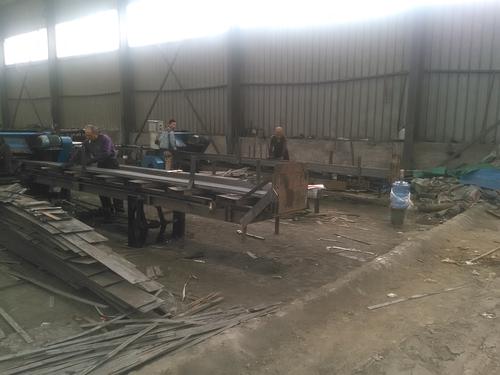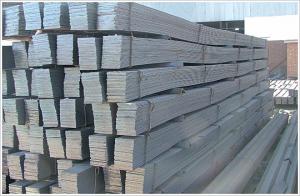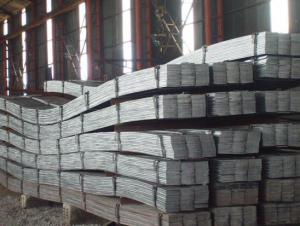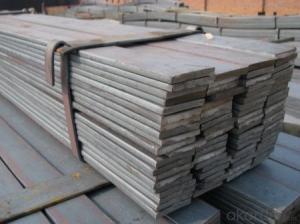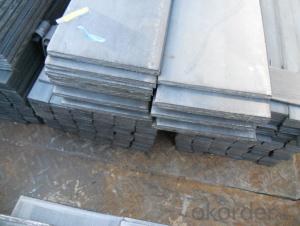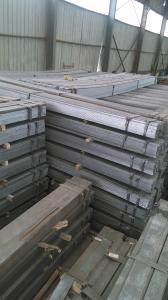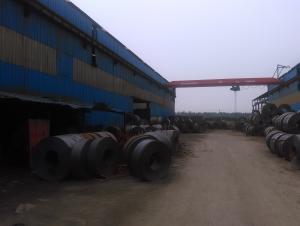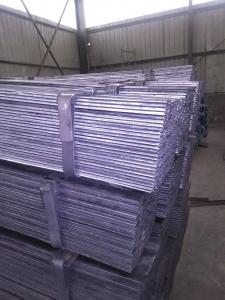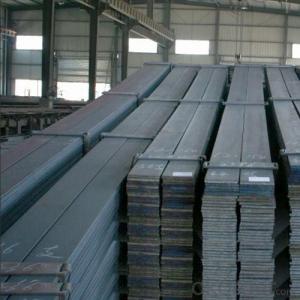ASTM A36 Steel Flat Iron Bars with Variety Sizes
- Loading Port:
- Tianjin
- Payment Terms:
- TT or LC
- Min Order Qty:
- 100 m.t.
- Supply Capability:
- 10000T m.t./month
OKorder Service Pledge
OKorder Financial Service
You Might Also Like
Product Description:
OKorder is offering ASTM A36 Steel Flat Iron Bars with Variety Sizes at great prices with worldwide shipping. Our supplier is a world-class manufacturer of steel, with our products utilized the world over. OKorder annually supplies products to African, South American and Asian markets. We provide quotations within 24 hours of receiving an inquiry and guarantee competitive prices.
Product Applications:
ASTM A36 Steel Flat Iron Bars with Variety Sizes are ideal for structural applications and are widely used in the construction of buildings and bridges, and the manufacturing, petrochemical, and transportation industries.
Product Advantages:
OKorder's ASTM A36 Steel Flat Iron Bars with Variety Sizes are durable, strong, and wide variety of sizes.
Main Product Features:
· Premium quality
· Prompt delivery & seaworthy packing (30 days after receiving deposit)
· Can be recycled and reused
· Mill test certification
· Professional Service
· Competitive pricing
Product Specifications:
Manufacture: slited
Slitting precision (width) : 0.5 mm or less
Raw material: Q235B, Q345B, Q235-1 b, A36
crosscutting precision (length) : 2 mm or less
Processing: the thickness of 2.0-16 mm;
Shear length: 2000 mm above
Wide degree: 15-1250 - mm;
Leveling precision: 1-2 MM square
Packaging: Export packing, nude packing, bundled
FAQ:
Q1: How many tons of steel products could be loaded in containers?
A1: Usually the steel products are delivered by bulk vessel because of the large quantity and the freight. However, there are no bulk vessel enter some seaports so that we have to deliver the cargo by containers. The 6m steel product can be loaded in 20FT container, but the quantity is changed according to the size, usually from 18tons to 25tons.
Q2: How do we guarantee the quality of our products?
A2: We have established an advanced quality management system which conducts strict quality tests at every step, from raw materials to the final product. At the same time, we provide extensive follow-up service assurances as required.
Q3: How soon can we receive the product after purchase?
A3: Within three days of placing an order, we will arrange production. The normal sizes with the normal grade can be produced within one month. The specific shipping date is dependent upon international and government factors, the delivery to international main port about 45-60days..
Images:
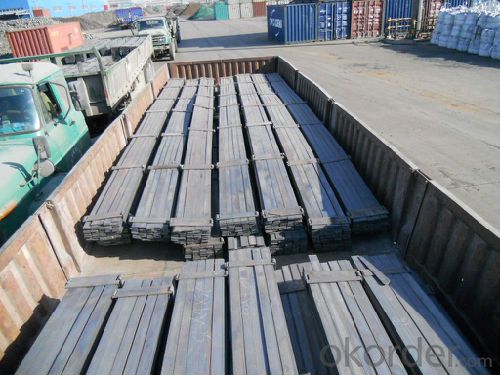
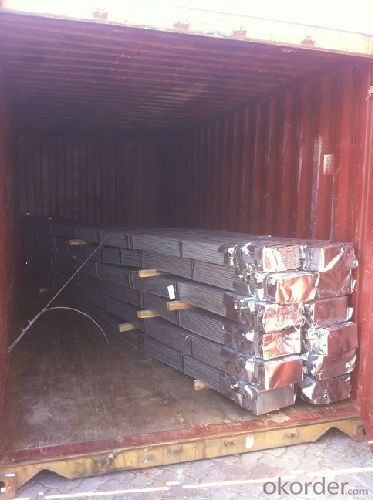
- Q: Can steel flat bars be hardened or heat-treated?
- Yes, steel flat bars can be hardened or heat-treated. Heat treatment processes such as quenching and tempering can be used to increase the hardness and strength of steel flat bars.
- Q: How do steel flat bars perform under load?
- Steel flat bars are known for their excellent strength and durability, making them highly capable of performing under heavy loads. They have a high tensile strength, which allows them to withstand significant amounts of weight without bending or breaking. This makes steel flat bars ideal for applications that require structural support or load-bearing capabilities.
- Q: How do you store steel flat bars to prevent damage?
- To store steel flat bars and prevent damage, there are a few key steps you can follow: 1. Choose a suitable storage area: Ensure the storage area is clean, dry, and well-ventilated. Avoid storing the flat bars in areas prone to moisture or extreme temperature fluctuations. If possible, designate a specific area for storing steel flat bars to minimize the risk of damage. 2. Use proper stacking techniques: When storing multiple steel flat bars, stack them horizontally on a flat surface. Make sure to align the bars properly, ensuring they are parallel to each other. Avoid stacking them too high to prevent excessive weight and potential bending or warping. 3. Employ appropriate supports: Place timber or rubber supports between the layers of stacked flat bars. These supports prevent direct contact between the bars, reducing the risk of scratches or surface damage. Using supports also helps distribute the weight evenly and maintain the flatness of the bars. 4. Protect against moisture: Moisture can cause rust or corrosion on steel flat bars. To prevent this, consider using moisture-absorbing materials such as silica gel packets or desiccants in the storage area. Additionally, cover the stacked bars with a plastic sheet or tarp to shield them from moisture and humidity. 5. Keep an organized inventory: Maintain a proper record of the stored steel flat bars, including their dimensions, grades, and quantities. Regularly inspect the inventory to identify any signs of damage, rust, or deformation. This will enable you to address any issues promptly and prevent further damage. 6. Handling and transportation precautions: When moving or transporting steel flat bars, use appropriate lifting equipment such as forklifts or cranes to avoid excessive stress on the bars. Always handle them with care and avoid dropping or dragging them, as this can cause dents, scratches, or deformation. By following these guidelines, you can ensure the proper storage of steel flat bars and minimize the risk of damage, preserving their quality and integrity.
- Q: What are the different surface coatings available for steel flat bars?
- Steel flat bars have a variety of surface coatings available, each with unique benefits and protection. The following are the most common types: 1. Galvanized Coating: By applying a layer of zinc to the steel flat bar's surface, galvanized coatings offer excellent corrosion resistance. They are commonly used in outdoor or marine environments where the steel is exposed to moisture and harsh conditions. 2. Powder Coating: This method involves electrostatically applying a dry powder to the steel flat bar, then curing it in an oven. It provides a durable and attractive finish, with a wide range of color options. Powder coatings are often used for decorative purposes and to protect against corrosion and wear. 3. Paint Coating: Used to protect against corrosion and enhance aesthetics, paint coatings are applied in multiple layers. A primer is used for better adhesion, and a topcoat adds extra protection. Paint coatings can be customized in terms of color and finish. 4. Epoxy Coating: Known for their resistance to chemicals, abrasion, and impact, epoxy coatings are applied as a liquid and then cured to form a hard, protective layer. They are often used in industrial and commercial applications with harsh environments or heavy usage. 5. Hot-Dip Coating: This process involves immersing the steel flat bar in a molten bath of zinc or other coating material. It creates a thick and durable coating with exceptional corrosion resistance. Hot-dip coatings are commonly used in construction, infrastructure, and automotive applications. 6. Chromium Coating: Chromium coatings, such as chrome plating or chrome alloy coatings, offer excellent resistance to corrosion, wear, and oxidation. They are applied through electroplating or thermal spray methods and are often used in applications requiring high hardness and a decorative finish. When choosing a surface coating for your steel flat bars, it is important to consider their specific requirements and operating conditions. Each coating type has its own advantages and limitations. Consulting with a coatings expert can help determine the most suitable option for your needs.
- Q: Are steel flat bars suitable for architectural metalwork?
- Architectural metalwork can utilize steel flat bars effectively. Steel possesses durability and strength, making it an ideal material for various architectural applications. Steel flat bars serve numerous purposes in architectural metalwork, including framing, structural support, and decorative elements. The advantages of steel flat bars in architectural metalwork are abundant. Firstly, their strength and rigidity enable them to handle heavy loads and provide structural stability. Consequently, they are suitable for constructing frameworks, beams, and other load-bearing components. Moreover, steel flat bars are easily manipulated and shaped to meet specific design requirements. They can be cut, welded, and bent to create intricate and customized architectural features. This versatility empowers architects and designers to incorporate unique and visually appealing elements into their projects. Furthermore, steel flat bars are available in various sizes, thicknesses, and finishes, providing designers with a wide range of options. They can be finished with coatings, such as paint or powder coating, to enhance their appearance and protect them from corrosion. Lastly, steel flat bars are cost-effective compared to alternative materials commonly used in architectural metalwork, like aluminum or stainless steel. Due to their affordability, they are a popular choice for projects with budget constraints. In conclusion, steel flat bars are highly suitable for architectural metalwork due to their strength, versatility, and cost-effectiveness. They empower designers and architects to create innovative and visually appealing structures while ensuring the necessary structural support and durability.
- Q: Is the laying of a 40X4 flat steel for fire fighting metal trunking?
- The cable tray is divided into trough, tray type and ladder format, network structure, and is composed of a bracket, bracket and installation accessories etc.. The building bridge can be set up independently, can also be attached to all kinds of building (structure) of buildings and pipe support, should reflect the characteristics of simple structure, beautiful appearance, flexible configuration and easy maintenance, etc., all parts are to be galvanized, installed in the building outside the open-air Bridge
- Q: Are steel flat bars used in the manufacturing of furniture?
- Yes, steel flat bars are commonly used in the manufacturing of furniture. They provide strength and stability, making them suitable for various applications such as table frames, chair legs, and shelving units.
- Q: How do I store steel flat bars to prevent damage?
- In order to prevent damage and ensure the preservation of steel flat bars, it is crucial to adhere to several important steps: 1. Opt for an appropriate storage location: Choose a clean, dry, and well-ventilated area that is free from moisture or extreme temperature fluctuations to store the steel flat bars. 2. Arrange the bars correctly: Arrange the bars horizontally in an organized and orderly manner to prevent warping or bending. Place wooden or rubber spacers between each layer to maintain proper separation and prevent scratches or dents. 3. Avoid direct contact with the floor: Keep the stacked bars elevated by using wooden pallets or racks to prevent any contact with the floor. This helps prevent moisture absorption and potential corrosion. 4. Safeguard against moisture: Utilize a weatherproof cover or wrap the stacked bars with plastic sheets to shield them from moisture present in the surroundings. Moisture can lead to rust and deterioration of the steel surface. 5. Conduct regular inspections and maintenance: Periodically inspect the stored steel flat bars for any indications of damage or corrosion. If any issues are identified, take appropriate measures to address them promptly. 6. Consider climate control: If you reside in an area with high humidity or significant temperature variations, it might be advantageous to invest in climate-controlled storage. This will help maintain optimal conditions for the steel flat bars and minimize the risk of damage. By adhering to these guidelines, the likelihood of damage to your steel flat bars during storage can be significantly reduced, ensuring their quality and longevity.
- Q: What are the different methods of surface etching for steel flat bars?
- Steel flat bars can be etched using various methods, each with its own advantages and applications. Here are some commonly used techniques: 1. Chemical Etching: By selectively removing the surface layer with chemical solutions or acids, this method allows for precise depth and pattern control. It is versatile, capable of creating intricate designs, logos, or text on the flat bar. 2. Electrochemical Etching: Also known as electrolytic etching, this method dissolves the surface layer using an electric current. A stencil or mask guides the process, making it ideal for permanent markings like part numbers or identification codes. 3. Laser Etching: Utilizing a high-powered laser without direct contact, this method ensures precise control and high-resolution patterns. It is frequently employed in industries that demand precision and permanence, like aerospace or medical equipment manufacturing. 4. Sandblasting: By propelling abrasive particles at high speed onto the flat bar's surface, sandblasting creates a textured or roughened finish. It is commonly used to enhance coating adhesion, create decorative finishes, or prevent slips. 5. Mechanical Etching: This technique physically removes the surface layer using mechanical means, such as milling, grinding, or polishing. It is often used to achieve specific finishes or textures for architectural or interior design purposes. Each method offers unique benefits, and the choice depends on the specific requirements of the application. Factors such as cost, precision, speed, and desired outcome should be considered when selecting the appropriate surface etching method.
- Q: What is the difference between a steel flat bar and a steel square tube?
- Steel flat bars and steel square tubes are two types of steel materials commonly utilized in construction and manufacturing. However, they vary in terms of shape and structural characteristics. The primary distinction lies in their cross-sectional shape. A steel flat bar boasts a rectangular form with two flat parallel surfaces and straight edges, whereas a steel square tube exhibits a hollow square shape with four equal sides and thicker walls. Concerning structural properties, a steel flat bar is typically employed for its strength in resisting bending or flexing. It frequently serves as a support or reinforcement in construction projects, such as framing or bracing. Conversely, a steel square tube provides superior strength and rigidity due to its hollow structure. It is frequently utilized as a structural element for load-bearing applications, such as building frameworks, machinery, or furniture manufacturing. Moreover, the manufacturing process for these two steel forms can differ. Steel flat bars are usually produced through hot rolling, which entails heating the steel billet and passing it through a series of rolling stands. This procedure yields a flat shape with smooth surfaces. Conversely, steel square tubes are generally manufactured through electric resistance welding (ERW), wherein a flat steel strip is transformed into a tube shape and subsequently welded along the edges. In conclusion, although both steel flat bars and steel square tubes are composed of the same material, their shape and structural properties render them suitable for distinct applications. Steel flat bars are commonly utilized for support and reinforcement purposes, while steel square tubes are preferred for load-bearing applications due to their enhanced strength and rigidity.
Send your message to us
ASTM A36 Steel Flat Iron Bars with Variety Sizes
- Loading Port:
- Tianjin
- Payment Terms:
- TT or LC
- Min Order Qty:
- 100 m.t.
- Supply Capability:
- 10000T m.t./month
OKorder Service Pledge
OKorder Financial Service
Similar products
Hot products
Hot Searches
Related keywords
